Part
Two – AMP
gauge WIRING FIXES
(Dodge was used for
this work shop model)
By
Mark Hamilton
We have seen
the weak areas, now we will make improvements.
The male/female flat blade terminals for the AMP
gauge wires at the firewall connector will be
eliminated–because they are the weakest link in the
system. The
AMP gauge will be disconnected and by-passed–because the
gauge often fails and sometimes it burns dashes.
Alternator output will be routed directly to the
BAT. POS. stud at the starter relay–because it’s the
most direct routing of power.
And, we will make use of both legs of the old AMP
gauge circuit–because it doubles the strength of the
main power-up circuit to the “welded splice,” which
serves as power distribution.
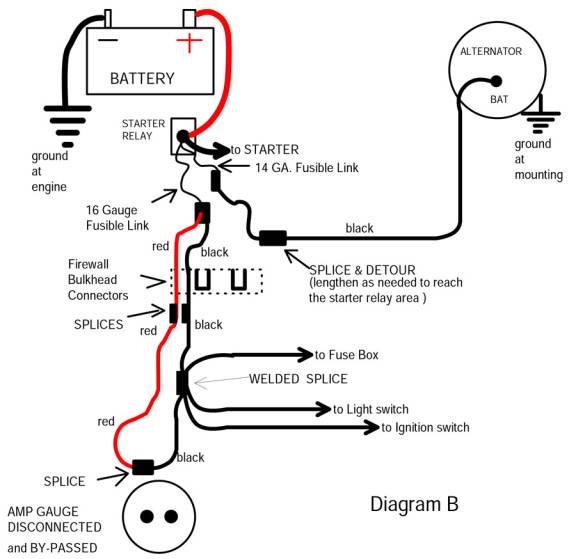
When everything
is working properly, the alternator is the source of power
to the entire electrical system. With this new system, we have alternator output delivered to
the BATTERY POSITIVE stud at the starter relay.
The stud at the starter relay now becomes the
“main buss” for power distribution.
Battery charging current will flow directly to the
battery, via the positive battery cable.
The “welded splice” in the dash wire harness
still serves as a junction for power distribution–but
now we are sending power to the “welded splice”
through both of the existing wires that were part of the
old AMP gauge system.
And the AMP gauge is by-passed.
The system mostly uses existing wires that were already in the wire
harness. But
since we are disconnecting, bypassing, and ignoring the
AMP gauge, we can rearrange the wires to form a much
stronger system. The
male/female terminals at the firewall connector are also
by-passed, the wires now pass directly through connector
body connection.
We
have also used the proper Fusible Link wires for short
circuit protection. A
14 gauge Fusible link is protecting the 10 black wire
circuit to the alternator.
And a 16 gauge Fusible link protects the power-up
wires to the “welded splice,” which serves as main
power distribution to the dash area.
Craftsmanship
and wire splicing methods will be critically important to
reliability with the new system.
We are working on wiring that must handle large
amounts of electrical power every time the truck is
driven. Our
work has to be good or the outcome will be no better than
the weak factory system.
We have to use a few splices to complete the
up-grade, and splicing is a job that not everyone does
well. Resistance
at all spices and connections must be minimized.
Crimp-on butt connectors with yellow plastic
insulation, wire nuts, or twisting and tapping wire
together will not be reliable splicing methods. The old method of crimp first, then solder, then insulate is
still the most reliable.
The
best parts for the job are non-insulated butt connectors,
which are made of copper and are tinned with solder.
Good quality shrinkable tubing will insulate the
splice, and a length of it must be slipped down the wire
before installing the butt connector.
We will also need a soldering gun or soldering
iron, and a lead/tin rosin core solder.

After
stripping the ends of the wires, we slipped shrinkable
tubing down the wire.
Then we crimped the non-insulated
butt connector onto the wires.
And then soldered the connection.
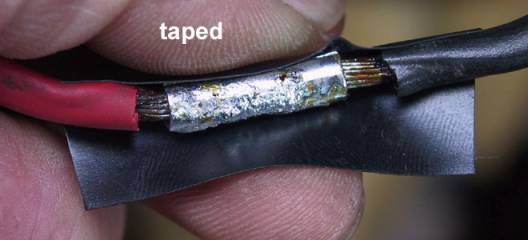
Electrical
tape may be used for the first layer of insulation, before
slipping the shrinkable tubing into place.
(We are using this option because it provides a
little extra padding and insulation over the splice.)

Then slide the shrinkable tubing into place, and
apply heat to shrink the tubing tightly for a good seal.
A disposable lighter works well when there is no
breeze.
A heat gun works very well and is safer too, as it
is flameless.
Hair driers do not produce enough heat to activate
the better shrinkable tubing. (The splice shown in the
photos above is where we have disconnected and by-passed
the AMP gauge at the dash.)
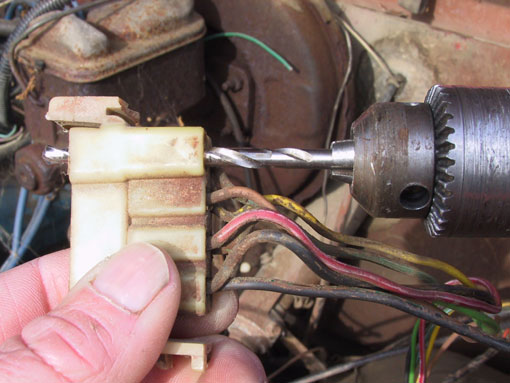
Using a drill slightly larger than the O.D. of a 10
gauge wire, we are drilling out one of the slots in the
engine side of the firewall connector body.
A new wire will pass directly through the connector
body without the weak male/female terminal arrangement.
Both sides of the bulkhead connector must be
drilled–the engine side and the dash wire harness side.
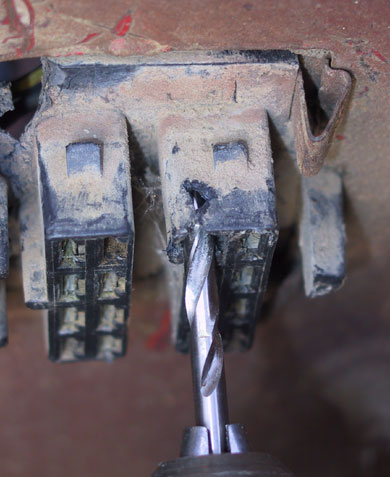
In
the photo above, we are drilling out the dash harness side
of the bulkhead connector.
Before drilling this side, check from under the
dash to be sure that wires are clear at the backside.
And drill just deep enough to go through the
connector–there are many wires at the other side, which
could be damaged by the drill.
This connector body is easily dismounted from the
firewall by releasing the latches.
Removing the connector body and then dragging it
under the dash will allow drilling it from the other side.
With either method, be sure to get the correct slot
so that the holes in both of the connector bodies will be
aligned after assembly.
Often the old terminal is melted into the plastic
connector body and tightly embedded.
If the terminal cannot be removed without breaking
the connector body, then we can use available unused slots
for the new direct pass-through.
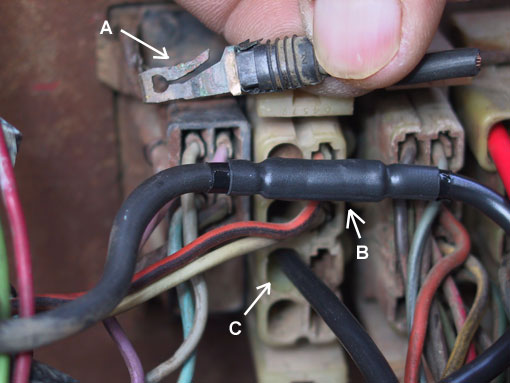
We have cut the original 10 gauge black wire from
the alternator to the connector, and then removed the
terminal with wire remnant from the connector body.
(see arrow A)
Splicing
on a new length of wire has lengthened the original
alternator output wire.
Now it is routed to the starter relay, where a
fusible link will be installed.
(Arrow B points to the splice.)
At the dash side of the firewall connector, we also
cut the wire and removed the terminal from the connector
body. And we
lengthened the wire at the dash side–it now passes
directly through the drilled out connector bodies.
(see arrow C)
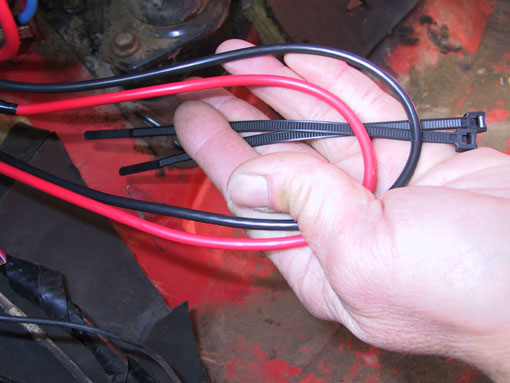
At
the dash side of the firewall connector, we have cut and
lengthened the red and black 10 gauge wires.
Both have been left long enough to pass through the
holes drilled in the connector body and reach out to the
starter relay area.
Plus we added an extra 12 to 15 inches in length,
which will be bundled to the dash harness.

The extra length bundled at the dash side of the
wires will provide opportunity for service work.
Should we ever need to inspect, test, or clean
other terminals at the connectors, we can always remove
the nylon ties and drag the extra length of wire through
the connector bodies.
Then the engine side connector body may be
unlatched and slipped over the 10 gauge wire for access to
terminals in the connector.

The photo at left shows the fusible Link
installations, where the new wires will connect to the
battery positive stud at the starter relay.
The red and
black 10 gauge wires connect to a 16 gauge fusible link
wire, which is actually identified as a metric size on
this particular fusible link.
(1.0 sq mm is the metric equivalent of 16 American
Wire Gauge size.)
This circuit powers up the welded splice in the
dash harness, which powers up all switches, fuses, and
circuits at the entire dash area.
Short-circuit
protection for the black 10 gauge wire to the alternator
is provided by a 14 gauge fusible link (the light colored
of the two, which is actually a 2.0 sq mm metric
equivalent.)
The up-grade really is quite simple, and it does
provide remarkable improvements to reliability and
electrical system performance.
The Dodge alternator/voltage regulator system will
perform well with the up-grade.
Expect more consistent voltage throughout the
system as resistance is significantly reduced at the main
power wiring.

Craftsmanship will have to be good, for the new
system to be reliable.
We are working with the main power delivery to the
entire electrical system.
Current to operate the entire system will flow from
the alternator, through this circuit, every time the
vehicle is driven.
Crimp-on
connectors will not be good enough!
They are prone to “Thermal Run-away” problems,
which is exactly what happened to the crimped on butt
connector shown in the above photo.
M.A.D. offers
very quality non-insulated terminals made of “tinned”
(solder coated) copper, which are perfect for the crimp
first, then solder, then insulate with shrinkable tubing
connections. (As
with the splice that shown in this feature.)
The “tech
is made simple” book, also available in through the
M.A.D. catalog, teaches splicing and soldering techniques,
all about the “Thermal Runaway” problem, and all about
Fusible Link wires.
And the M.A.D.
catalog offers excellent wire strippers and terminal
crimping tool, ideally suited for this kind of work.
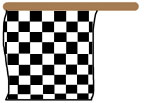

|